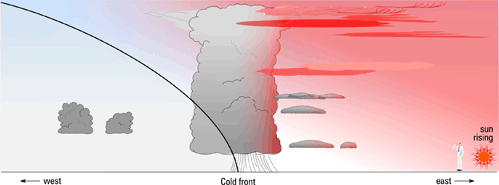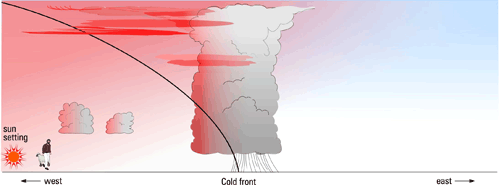An old weather saying; and a good one. There are many references to this on the Internet and I haven’t read any of them and I won’t link to any here. This will be yet another discussion of this old adage.
I have often heard the saying repeated, and I have said it myself on occasion. There seem to be several versions. This is the one I learned from my Mum when I was young, and it is the one I use now, and teach to my grand children:
Red sky at night, Shepherd’s delight. Red sky in the morning, Sailor’s warning.
I'm not going to argue about shepherds and sailors; that’s not important here. The questions are: “Is it a useful saying? Does it work? If it works, why?”

Red sky in the morning...
In the mid-latitudes weather systems migrate around the hemisphere from west to east. “Red sky in the morning...” is describing how, soon after dawn, the rising sun illuminates the cloud masses of the weather approaching from the west. The whole sky is ablaze with shades of red, orange and pink. It is not enough that a few clouds in the east are red. When this saying works, it is when the whole sky is involved. The red sky warns the sailor of the approaching weather – strong, possibly gale force winds, bad visibility in rain, and possibly thunderstorms. “Shorten sail! Set course for a sheltered cove!”

Red sky at night...
“Red sky at night...” refers to the setting sun lighting up the cloud of the weather system as it moves away eastwards. Again, a substantial part of the sky is in red and orange tones, not just the sky in the west. The shepherd can expect a peaceful night in the open, and not be too concerned about wind and rain.
But why red? We know why the daytime sky is blue. It is blue because short wavelength light (blue) is scattered by the gas molecules in the atmosphere more strongly than long wavelength light (red). So, the blue colour is from the short wavelength light that has been scattered from all over the illuminated atmosphere.
The sunlight at sunrise and sunset is red because it is shining through a much thicker slab of atmosphere, and all the shorter wavelength light has been scattered away leaving only the red long wavelengths.